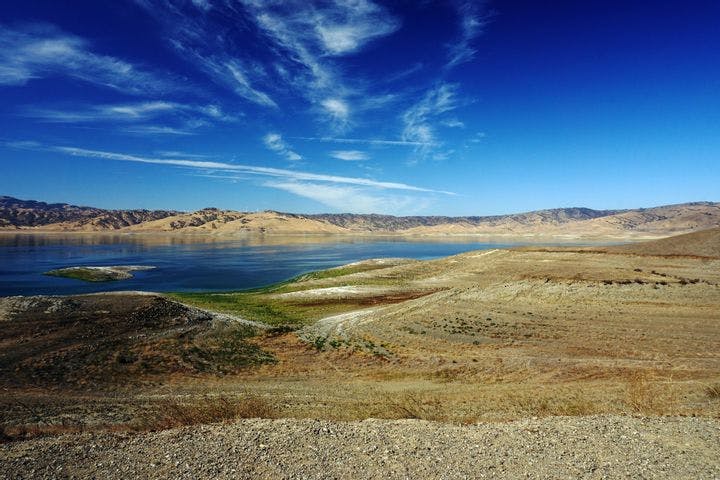Winter 2009
Showdown at Dry Gulch
– Geoff Manaugh
Geoff Manaugh examines a "historically important, well-timed, and memorable addition to the growing library of books about water and the West."
Any book about dams and water politics in the American West risks comparison to a daunting predecessor: Marc Reisner’s Cadillac Desert: The American West and Its Disappearing Water (1986), the standard reference for an unusually complex field. Indeed, the breadth and moral conviction of Reisner’s argument against the irrational excesses of western water use has yet to be matched. Nonetheless, in Dead Pool, James Lawrence Powell achieves something that Reisner did not: force of concentration.
Powell, executive director of the National Physical Science Consortium, focuses on just one dam: northern Arizona’s Glen Canyon Dam, constructed starting in 1956 on a remote stretch of the Colorado River. Dead Pool zeroes in on the astonishing complication of factors—legislative, topographic, and meteorological—that shaped the dam’s creation. While the bulk of the book describes the rapid growth of the Bureau of Reclamation, a branch of the U.S. Department of the Interior founded in 1902 to help irrigate the desert West, it also reminds us of the strangeness of the waterworld in which the western states now thrive.
In the 1950s, the Colorado River, flowing from the Rockies to the Gulf of California, presented an irresistible target for industry lobbyists, politicians, and federal hydrologists inspired as much by the experience of the Dust Bowl as by the electrical and agricultural needs of a westward-moving population. Hoover Dam, née Boulder Dam, had proved, upon completion in 1935, that the canyons of the West could be dammed; the Grand Canyon itself, incredibly, had only barely missed being flooded in the early 1950s.
The upper basin states—Colorado, Utah, New Mexico, and Wyoming—needed their own reservoir to help protect against the future thirst of California, and the federal government responded by building Glen Canyon Dam. Behind it is Lake Powell, an artificial sea capable of storing 27 million acre-feet of water and, after spinning through the dam’s eight 155,000-horsepower turbines, generating more than four billion kilowatt-hours of electricity a year.
The construction of Glen Canyon Dam was not an act of collaborative hydrology. The Colorado River states are, in fact, in stiff competition with one another, and Powell forecasts dire consequences for their inability to agree on future water rights. “As the hydrologic system falters,” he suggests, outlining a scenario in which long-term severe drought returns to the West, “how might the legal system respond?” His short answer: It won’t. A regulatory labyrinth of unbelievable proportions has emerged, functioning, like all true bureaucracies, at the precise intersection of illogic and inertia, and helping to produce absurd irrigation schemes worthy of a Monty Python sketch. (As Powell understatedly points out, “Reclaimed lands had often proved to be worth less than the money it took to irrigate them.”)
While Dead Pool’s environmental politics are relatively easy to parse, it’s unclear what Powell advocates. Radical conservation of local water resources? Wholesale abandonment of the West? Central—that is, federal—control over the rivers of the western states? Or a states-based approach to water management? These are fundamental questions involving water rights, taxation, agricultural productivity, endangered species displaced by flooding, summer lakeside recreation, and electrical power for tens of millions of voting Americans.
It is precisely the lack of easy answers that leads Powell, late in the book, to break away from history altogether and write what could be called speculative nonfiction, predicting the future of Glen Canyon Dam—and of the American West in general. We go 10, 20, 50 years into the future, and watch climate change and drought afflict the region, dams fill with silt, and whole cities go thirsty, their lights fading into darkness. At times, the book verges on the apocalyptic: “One day every trace of the dams and their reservoirs will be gone, a few exotic grains of concrete the only evidence of their one-time existence.”
While Powell’s vision of the future is not always convincing, Dead Pool ends as a historically important, well-timed, and memorable addition to the growing library of books about water and the West.
* * *
Geoff Manaugh is senior editor of Dwell magazine; his blog, BLDGBLOG, can be found at bldgblog.blogspot.com. The BLDGBLOG Book is forthcoming this spring.
Reviewed: Dead Pool: Lake Powell, Global Warming, and the Future of Water in the West by James Lawrence Powell, University of California Press, 283 pp, 2011.
Photo courtesy of the U.S. Department of Agriculture
Up next in this issue
